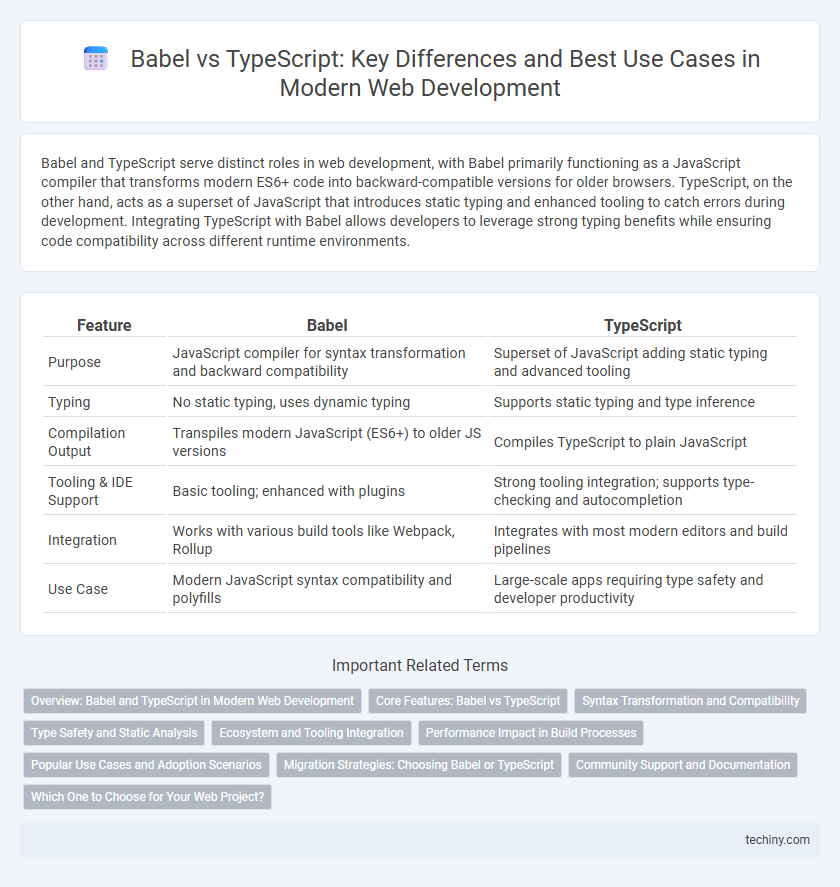Babel and TypeScript serve distinct roles in web development, with Babel primarily functioning as a JavaScript compiler that transforms modern ES6+ code into backward-compatible versions for older browsers. TypeScript, on the other hand, acts as a superset of JavaScript that introduces static typing and enhanced tooling to catch errors during development. Integrating TypeScript with Babel allows developers to leverage strong typing benefits while ensuring code compatibility across different runtime environments.
Table of Comparison
| Feature | Babel | TypeScript |
|---|---|---|
| Purpose | JavaScript compiler for syntax transformation and backward compatibility | Superset of JavaScript adding static typing and advanced tooling |
| Typing | No static typing, uses dynamic typing | Supports static typing and type inference |
| Compilation Output | Transpiles modern JavaScript (ES6+) to older JS versions | Compiles TypeScript to plain JavaScript |
| Tooling & IDE Support | Basic tooling; enhanced with plugins | Strong tooling integration; supports type-checking and autocompletion |
| Integration | Works with various build tools like Webpack, Rollup | Integrates with most modern editors and build pipelines |
| Use Case | Modern JavaScript syntax compatibility and polyfills | Large-scale apps requiring type safety and developer productivity |
Overview: Babel and TypeScript in Modern Web Development
Babel and TypeScript are essential tools in modern web development, both transforming code to enhance compatibility and productivity. Babel primarily focuses on transpiling modern JavaScript (ES6+) into backward-compatible versions, enabling developers to use the latest syntax without worrying about browser support. TypeScript extends JavaScript by adding static types, enabling developers to catch errors early and improve code maintainability while also compiling to plain JavaScript for broad execution.
Core Features: Babel vs TypeScript
Babel is a JavaScript compiler primarily focused on transpiling modern ECMAScript code into backward-compatible versions for older browsers, supporting plugins for syntax transformations and polyfills. TypeScript is a superset of JavaScript that adds static typing, interfaces, and compile-time error checking, enhancing code quality and maintainability. While Babel excels in syntax transformation and plugin extensibility, TypeScript emphasizes type safety and development-time tooling with its robust type system.
Syntax Transformation and Compatibility
Babel excels at syntax transformation by converting modern JavaScript (ES6+) into backward-compatible versions for older browsers, supporting a vast ecosystem of plugins for customized transpilation. TypeScript extends JavaScript with static typing and compiles to clean JavaScript, offering seamless integration with Babel for enhanced compatibility and early error detection. While Babel primarily focuses on syntax transformation, TypeScript provides both type checking and syntax compatibility, ensuring robust codebases across diverse runtime environments.
Type Safety and Static Analysis
TypeScript enhances web development with robust type safety by providing static type checking at compile time, reducing runtime errors and improving code quality. Babel primarily focuses on JavaScript transpilation without built-in type safety, relying on external tools for static analysis. TypeScript's integrated static analysis tools enable early detection of type mismatches and potential bugs, streamlining debugging and maintenance.
Ecosystem and Tooling Integration
Babel offers extensive integration with major build tools like Webpack and Rollup, supporting a wide range of JavaScript syntax transformations and plugins that enhance the development workflow. TypeScript provides a robust ecosystem with strong support for IDEs such as Visual Studio Code, leveraging its static type checking and IntelliSense to improve developer productivity. Large-scale projects benefit from TypeScript's deep tooling integration for refactoring, code navigation, and error detection, while Babel excels in flexible transpilation for diverse JavaScript environments.
Performance Impact in Build Processes
Babel and TypeScript both influence build performance, with Babel typically offering faster transpilation due to its focus on syntax transformation without full type checking. TypeScript performs comprehensive type checking which adds overhead to build times but enhances code reliability and maintainability. Optimizing build performance often involves using Babel for faster incremental builds and leveraging TypeScript's type checking during separate compilation steps or continuous integration pipelines.
Popular Use Cases and Adoption Scenarios
Babel is predominantly used for transpiling modern JavaScript (ES6+) to ensure compatibility across different browsers and environments, making it ideal for projects requiring wide browser support and incremental adoption of new language features. TypeScript is widely adopted in large-scale applications requiring static type checking, enhanced code maintainability, and improved developer tooling, often favored in enterprise environments and complex React or Node.js projects. Both tools can be combined effectively, with Babel handling syntax transformation and TypeScript performing type checking, optimizing development workflows for diverse JavaScript ecosystems.
Migration Strategies: Choosing Babel or TypeScript
Migrating a project requires evaluating Babel's simpler setup for transpiling modern JavaScript against TypeScript's comprehensive type-checking capabilities for enhanced code maintainability. Babel enables a gradual migration by allowing incremental adoption of newer JavaScript features without changing existing code structure, while TypeScript demands a more deliberate transition with type annotations and configuration adjustments. Choosing between Babel and TypeScript hinges on project complexity, team expertise, and the need for static type safety versus lightweight compilation.
Community Support and Documentation
Babel and TypeScript both feature robust community support, with Babel benefiting from a vast ecosystem centered on JavaScript transpilation and plugin development, while TypeScript offers extensive backing through Microsoft's active contributions and a growing developer base in typed JavaScript adoption. TypeScript's comprehensive, well-maintained documentation provides clear guidelines on static typing and advanced language features, whereas Babel's documentation focuses on plugin architecture and JavaScript version compatibility. Developer forums, GitHub repositories, and Stack Overflow show higher activity for TypeScript's type system discussions, while Babel's community thrives on configuration and plugin customization topics.
Which One to Choose for Your Web Project?
Choosing between Babel and TypeScript depends on your project's requirements: Babel is a versatile JavaScript compiler that focuses on transpiling ES6+ syntax to ensure browser compatibility, making it ideal for projects needing broad environment support. TypeScript offers static typing, which enhances code quality and maintainability by catching errors early and facilitating robust tooling, suitable for large-scale or team projects. For maximum efficiency, many developers combine both tools by using TypeScript for type checking and Babel for transpilation, leveraging the strengths of each in modern web development.
Babel vs TypeScript Infographic

 techiny.com
techiny.com